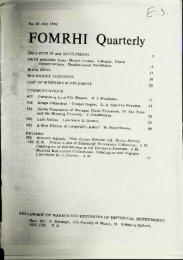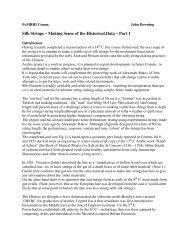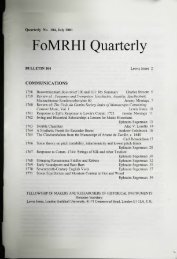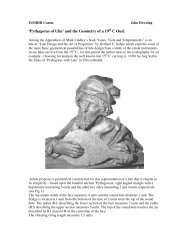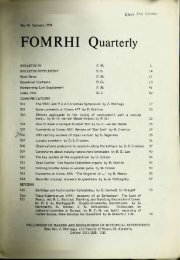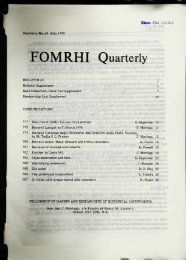•rf - FoMRHI
•rf - FoMRHI
•rf - FoMRHI
You also want an ePaper? Increase the reach of your titles
YUMPU automatically turns print PDFs into web optimized ePapers that Google loves.
B a ^^^^^^^^^^^" the existence of many 16th century Spanish<br />
broadsheets showing illustrations of vihuelas and guitars. One, reproduced on the<br />
dust jacket of the Jacobs edition of Milan's works. having 4 strings and a string length<br />
of 40 cm, seems to be a small guitar. Another used by Mason on publicity handoufs<br />
for his Dee. lst Wigmore Hall recital shows 6 strings over the body (ambiguous over<br />
the fingerboard) and a string length of 54 cm. It could be either a particularly small<br />
vihuela (equivalent to the English treble lute) or a normal guitar. If such small vihuelas<br />
of equal size to larger guitars existed (perhaps being distinguished by number of courses<br />
and back curvature) then they, together with the 80 cm size would be able to play the<br />
duets for two vihuelas tuned a fifth apart by Valdarrabano'^ These broadsheets certainly<br />
need to be looked at. ^<br />
APPENDIX I. THE SCALING OF INSTRUMENTS IN SCULPTURES AND PICTORIAL<br />
REPRESENTATIONS<br />
Ideally we should have tabulated a set of average dimensions of people and their<br />
clothing, taking into account age, sex, social standing, period and locality. We uoufj<br />
relate instrument sizes with those features most reliably known and easy to measure.<br />
The data are unfortunately not available to us now. There are data on variation in<br />
stature with time in the literature, but ali we have found so far is a comparison of<br />
the average modem man's height 5ft 9in with his height in 1700 of 5ft 4Qin, a<br />
difference of 65%. Armour in museums testifies to medieval and Renaissance<br />
shortness. It is said that nutritional factors are probably responsible, and that<br />
their greatest innuence on ultimate bone size occurs during babyhood. Cranial<br />
development is more advanced than other bone growth at birth and this could mean<br />
that head dimensions are less affected by nutrition than other measurements. Head<br />
size is usually very difficult to estimate in art works because of hair styles and<br />
other head coverings.<br />
There are two measures relating to head size, either one or the other of which is<br />
usually available on represenlations. One is the interocular (pupil-to-pupil eye)<br />
distance and the other is the distance between the mouth opening and the centre<br />
point between the eyes. On pictorial representations the former is more useful if<br />
the subject's face is pointed close to or above or below the observer. The latter is<br />
more useful if it is pointed to the side of the Viewer.<br />
Until better data becomes available we decided to use measurements of modem<br />
people for our scaling. On 8 adulta, which included members of the household and<br />
guests, we measured the interocular distance and the moulh-centre of eyes distances<br />
and the average values were 63.2 mm and 64.6 mm respectively. The root mean<br />
square deviations of the measurements from these averages were 3.6 mm (5.7£) and<br />
5.3 mm (8.27) respectively. We noticed that there was a tendency for people who<br />
were particularly high in one of these parameters to be low in the other, and vice versa.<br />
Consequently, we averaged the parameters for each individuai first and then found<br />
the root mean square deviations of the individuals was 1.8 mm (2.8^) about the mean<br />
of 63.9 mm.<br />
Considering the errors involved and the probability that Renaissance people were a<br />
bit smaller, we have decided to use 63 mm as a standard estimate for either of<br />
these measures, and to add or subtract a few mm. if the facial proportions on the<br />
re presentation seem to resemble those of the more aberrant of the people measured.<br />
We hope that these estimates will be precise to within a semitone or 6%. We cannot<br />
guarantee that the artists maintained this level of accuracy, but they offer most of<br />
the data on instrument sizes that we have, and such data must be taken very seriously.





